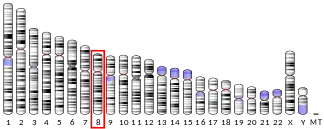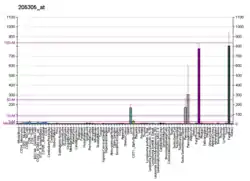| FGL1 | |||||||||||||||||||||||||||||||||||||||||||||||||||
|---|---|---|---|---|---|---|---|---|---|---|---|---|---|---|---|---|---|---|---|---|---|---|---|---|---|---|---|---|---|---|---|---|---|---|---|---|---|---|---|---|---|---|---|---|---|---|---|---|---|---|---|
| Identifiers | |||||||||||||||||||||||||||||||||||||||||||||||||||
| Aliases | FGL1, HFREP1, HP-041, LFIRE-1, LFIRE1, fibrinogen like 1, HPS | ||||||||||||||||||||||||||||||||||||||||||||||||||
| External IDs | OMIM: 605776 MGI: 102795 HomoloGene: 37927 GeneCards: FGL1 | ||||||||||||||||||||||||||||||||||||||||||||||||||
| |||||||||||||||||||||||||||||||||||||||||||||||||||
| |||||||||||||||||||||||||||||||||||||||||||||||||||
| |||||||||||||||||||||||||||||||||||||||||||||||||||
| |||||||||||||||||||||||||||||||||||||||||||||||||||
| Wikidata | |||||||||||||||||||||||||||||||||||||||||||||||||||
| |||||||||||||||||||||||||||||||||||||||||||||||||||
Fibrinogen-like protein 1 (FGL-1) is a protein that is structurally related to fibrinogen. In humans, FGL-1 is encoded by the FGL1 gene.[5][6] Four splice variants exist for this gene.
Function
Fibrinogen-like protein 1 is a member of the fibrinogen family of proteins, which also includes fibrinogen, fibrinogen-like protein 2, and clotting factors V, VIII, and XIII. FGL-1 is homologous to the carboxy terminus of the fibrinogen beta- and gamma- subunits which contains the four conserved cysteines of that are common to all members of the fibrinogen family. However, FGL-1 lacks the platelet-binding site, cross-linking region, and thrombin-sensitive site which allow the other members of the fibrinogen family to aid in fibrin clot formation.[6]
FGL-1 has also been observed to strongly bind to and activate LAG-3, a regulatory protein expressed on T cells. As LAG-3 has an important role in controlling activated T cells, manipulating FGL-1 binding to T cells has been proposed for both cancer immunotherapy and anti-inflammatory treatments.[7]
Clinical significance
FGL-1 may play a role in the development of hepatocellular carcinomas.[6]
References
- 1 2 3 GRCh38: Ensembl release 89: ENSG00000104760 - Ensembl, May 2017
- 1 2 3 GRCm38: Ensembl release 89: ENSMUSG00000031594 - Ensembl, May 2017
- ↑ "Human PubMed Reference:". National Center for Biotechnology Information, U.S. National Library of Medicine.
- ↑ "Mouse PubMed Reference:". National Center for Biotechnology Information, U.S. National Library of Medicine.
- ↑ Yamamoto T, Gotoh M, Sasaki H, Terada M, Kitajima M, Hirohashi S (Jul 1993). "Molecular cloning and initial characterization of a novel fibrinogen-related gene, HFREP-1". Biochem Biophys Res Commun. 193 (2): 681–7. doi:10.1006/bbrc.1993.1678. PMID 8390249.
- 1 2 3 "Entrez Gene: FGL1 fibrinogen-like 1".
- ↑ Wang J, Sanmamed MF, Datar I, Su TT, Ji L, Sun J, et al. (January 2019). "Fibrinogen-like Protein 1 Is a Major Immune Inhibitory Ligand of LAG-3". Cell. 176 (1–2): 334–347.e12. doi:10.1016/j.cell.2018.11.010. PMC 6365968. PMID 30580966.
Further reading
- Maruyama K, Sugano S (1994). "Oligo-capping: a simple method to replace the cap structure of eukaryotic mRNAs with oligoribonucleotides". Gene. 138 (1–2): 171–4. doi:10.1016/0378-1119(94)90802-8. PMID 8125298.
- Suzuki Y, Yoshitomo-Nakagawa K, Maruyama K, et al. (1997). "Construction and characterization of a full length-enriched and a 5'-end-enriched cDNA library". Gene. 200 (1–2): 149–56. doi:10.1016/S0378-1119(97)00411-3. PMID 9373149.
- Hara H, Yoshimura H, Uchida S, et al. (2001). "Molecular cloning and functional expression analysis of a cDNA for human hepassocin, a liver-specific protein with hepatocyte mitogenic activity". Biochim. Biophys. Acta. 1520 (1): 45–53. doi:10.1016/s0167-4781(01)00249-4. PMID 11470158.
- Strausberg RL, Feingold EA, Grouse LH, et al. (2003). "Generation and initial analysis of more than 15,000 full-length human and mouse cDNA sequences". Proc. Natl. Acad. Sci. U.S.A. 99 (26): 16899–903. Bibcode:2002PNAS...9916899M. doi:10.1073/pnas.242603899. PMC 139241. PMID 12477932.
- Zeng L, Dai J, Ying K, et al. (2003). "Identification of a novel human angiopoietin-like gene expressed mainly in heart". J. Hum. Genet. 48 (3): 159–62. doi:10.1007/s100380300025. PMID 12624729.
- Yan J, Yu Y, Wang N, et al. (2004). "LFIRE-1/HFREP-1, a liver-specific gene, is frequently downregulated and has growth suppressor activity in hepatocellular carcinoma". Oncogene. 23 (10): 1939–49. doi:10.1038/sj.onc.1207306. PMID 14981537. S2CID 9243597.
- Gerhard DS, Wagner L, Feingold EA, et al. (2004). "The status, quality, and expansion of the NIH full-length cDNA project: the Mammalian Gene Collection (MGC)". Genome Res. 14 (10B): 2121–7. doi:10.1101/gr.2596504. PMC 528928. PMID 15489334.
- Rual JF, Venkatesan K, Hao T, et al. (2005). "Towards a proteome-scale map of the human protein-protein interaction network". Nature. 437 (7062): 1173–8. Bibcode:2005Natur.437.1173R. doi:10.1038/nature04209. PMID 16189514. S2CID 4427026.
- Rijken DC, Dirkx SP, Luider TM, Leebeek FW (2006). "Hepatocyte-derived fibrinogen-related protein-1 is associated with the fibrin matrix of a plasma clot". Biochem. Biophys. Res. Commun. 350 (1): 191–4. doi:10.1016/j.bbrc.2006.09.018. PMID 16996032.
- Liu Z, Ukomadu C (2008). "Fibrinogen-like protein 1, a hepatocyte derived protein is an acute phase reactant". Biochem. Biophys. Res. Commun. 365 (4): 729–34. doi:10.1016/j.bbrc.2007.11.069. PMC 2288651. PMID 18039467.




